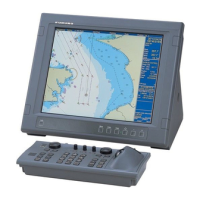18. Common Reference System
18-3
18.2.1 Shared alarm management
The common reference system concept provides that all alarms are indicated in all workstations and a single
acknowledge of alarm from any workstation is enough to acknowledge the alarm from all workstations.
18.2.2 Harmonized databases on workstations
When the multi-workstation mode is used, information between workstations is shared via the access server. The
access server is responsible for harmonizing data on all workstations when any data listed below has been changed
in one of the workstations.
• Chart data
• ARCS
• S57
• Manual updates
• Permits
Notes on harmonization
• If you have the multi-workstation mode in use, it is recommended that loading or updating of ARCS and S57
charts be made when the ship is NOT
sailing on restricted waters, because harmonising of databases may cause
delay in system operations. To load or update charts while sailing, switch to single-workstation mode. For how
to change the mode, see section 18.5 Mode of Workstations.
• In the multi-workstation mode, ECDIS charts are harmonized whenever a chart is loaded, removed, manually
updated, viewing dates set, etc. If harmonization is executed between ECDIS units operating in the single-
workstation mode, however, the ECDIS workstation having the latest "global_catalog.cat" is used for
harmonization. This can cause loss of charts if, for example, the ECDIS workstation to be harmonized has more
charts than the other ECDIS workstation but its global_catalog.cat is older than the ECDIS workstation with
fewer charts.
• The date of modification of global_catalog.cat for both the S57 system and ARCS system is changed whenever
respective charts are loaded, deleted, etc. Both chart systems are harmonized with the latest charts, with no order
or priority. The date of global_catalog.cat is modified in the following instances: Permit loading, Permit
removal, Chart loading, Chart update, Chart removal, Manual chart viewing dates, Manual update, etc.
• When ECDIS is installed or updated, global_catalog.cat of both the ARCS system and S57 system is deleted.
After ECDIS is restarted, rebuild is executed to create a new global_catalog.cat, and the newly created file is
time-stamped "Monday, January 01, 1601 9:00:00 AM". (This happens only when it and the S57_setup_file are
deleted together. If only global_catalog.cat is deleted, the current time stamp is applied.)
This usually presents no problem with harmonization of S57 charts. However, if "Permanent Warning" appears
during the rebuild, "Set chart viewing date" will be executed. When this occurs, the time stamp for
global_catalog.cat is written over and its time stamp becomes older than the ECDIS time stamp. This causes the
ECDIS to revert to the harmonized state directly after installation. To prevent this, "use" the time stamp obtained
from "Set chart viewing date" and execute "Set chart viewing date" on the ECDIS on which to harmonize S57
charts. This will always give the most recent time stamp to the ECDIS to be harmonized.
• Do not turn off the power of an ECDIS unit when charts are being harmonized between two ECDIS units in the
multi-workstation mode. The unit that was turned off may malfunction after activating the single-workstation
mode.
• Turn off the radar overlay feature before conducting harmonization after loading or updating charts, to prevent
the overload condition, which causes slow operation.
• For multi-workstation system, if charts are loaded and updated at Workstation A in the single mode
then the
mode is switched to multimode
, charts are then automatically loaded to Workstation B for harmonization of
charts. After harmonization is completed, charts must be refreshed at Workstation B, in the following operating
sequence: Chart menu→System→Refresh charts after backup. This same operating procedure applies if charts
are loaded and updated while the multi-workstation mode is active.

